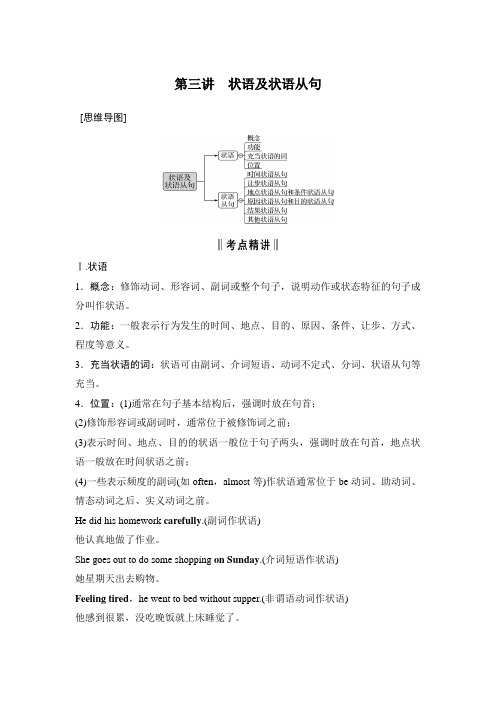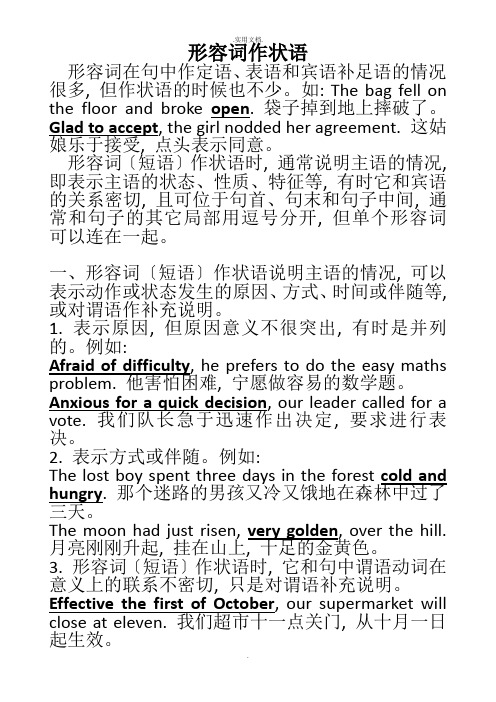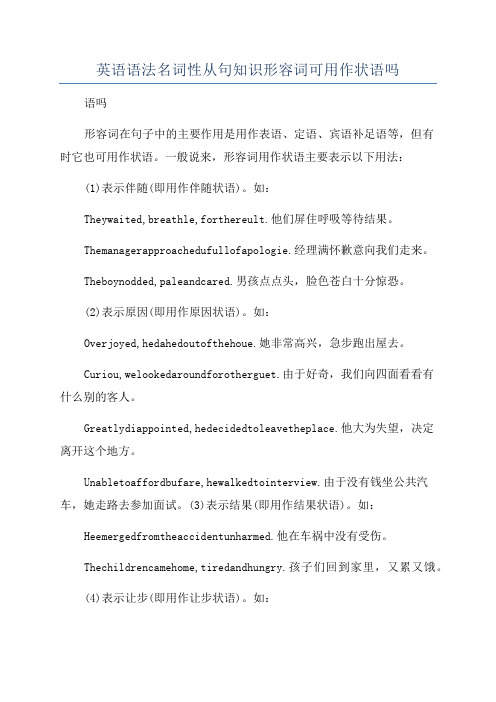高考英语语法之形容词作状语
高考英语语法突破: 状语及状语从句

第三讲状语及状语从句[思维导图]Ⅰ.状语1.概念:修饰动词、形容词、副词或整个句子,说明动作或状态特征的句子成分叫作状语。
2.功能:一般表示行为发生的时间、地点、目的、原因、条件、让步、方式、程度等意义。
3.充当状语的词:状语可由副词、介词短语、动词不定式、分词、状语从句等充当。
4.位置:(1)通常在句子基本结构后,强调时放在句首;(2)修饰形容词或副词时,通常位于被修饰词之前;(3)表示时间、地点、目的的状语一般位于句子两头,强调时放在句首,地点状语一般放在时间状语之前;(4)一些表示频度的副词(如often,almost等)作状语通常位于be动词、助动词、情态动词之后、实义动词之前。
He did his homework carefully.(副词作状语)他认真地做了作业。
She goes out to do some shopping on Sunday.(介词短语作状语)她星期天出去购物。
Feeling tired,he went to bed without supper.(非谓语动词作状语)他感到很累,没吃晚饭就上床睡觉了。
Ⅱ.状语从句一、时间状语从句1.when,while与as引导的时间状语从句Metals expand when they are heated.金属受热时膨胀。
While /When I was reading,he came in.我正在看书时,他进来了。
The students sang as they walked.学生们边走边唱。
2.before与since引导的时间状语从句(1)before与since的常用句式It will be half a year before I come back.我半年之后才回来。
It won’t be long before we meet again.用不了多久我们就会再见面。
It was three days before he came back.三天后他才回来。
高中英语语法形容词作状语

.实用文档.形容词作状语形容词在句中作定语、表语和宾语补足语的情况很多, 但作状语的时候也不少。
如: The bag fell on the floor and broke open. 袋子掉到地上摔破了。
Glad to accept, the girl nodded her agreement. 这姑娘乐于接受, 点头表示同意。
形容词〔短语〕作状语时, 通常说明主语的情况, 即表示主语的状态、性质、特征等, 有时它和宾语的关系密切, 且可位于句首、句末和句子中间, 通常和句子的其它局部用逗号分开, 但单个形容词可以连在一起。
一、形容词〔短语〕作状语说明主语的情况, 可以表示动作或状态发生的原因、方式、时间或伴随等, 或对谓语作补充说明。
1. 表示原因, 但原因意义不很突出, 有时是并列的。
例如:Afraid of difficulty, he prefers to do the easy maths problem. 他害怕困难, 宁愿做容易的数学题。
Anxious for a quick decision, our leader called for a vote. 我们队长急于迅速作出决定, 要求进行表决。
2. 表示方式或伴随。
例如:The lost boy spent three days in the forest cold and hungry. 那个迷路的男孩又冷又饿地在森林中过了三天。
The moon had just risen, very golden, over the hill. 月亮刚刚升起, 挂在山上, 十足的金黄色。
3. 形容词〔短语〕作状语时, 它和句中谓语动词在意义上的联系不密切, 只是对谓语补充说明。
Effective the first of October, our supermarket will close at eleven. 我们超市十一点关门, 从十月一日起生效。
英语形容词作状语完美解答

英语形容词作状语完美解答英语形容词作状语完美解答形容词作状语详解一般情况下,语法书中对形容词是这样描述的:用来修饰和说明名词或代词,表示人或物的性质、性质和状态,其语法功能是在句中可以作定语、表语、宾语补足语,而很少或根本没有提到可以作状语。
但在英语实际运用中,形容词是可以用作状语。
请看2021年高考英语全国卷II 单选题中有这么一道题: After the long journey, the three of the went back home, _______.A. hungry and tiredlyB. hungry and tiredC. hungrily and tiredlyD. hungrily and tired正确答案是:B 。
该题考查的是形容词作状语,即考查了形容词(组)作状语。
tired 是由过去分词转化来的形容词,也称分词形容词。
形容词(组)作状语通常修饰谓语动词,具有副词功能,是中学英语重难点语法项目,也是高考常考知识点。
高三复习备考时归纳总结这一结构的用法,熟悉其特征,可以更好地帮助同学们提高综合运用英语知识的能力。
笔者结合平时的教学就这一知识点进行了一些归纳和况结,希望对同学们有帮助。
一、作原因状语,通常位于句首。
window. (=As she was thirsty and eager to get a little rest, she went into the restaurant and ...)由于口渴,又渴望休息,她走进饭店,在靠窗的桌旁坐下。
二、作伴随状语,置于句首或句末均可。
小偷躲在角落里,担心被人抓住。
孩子们又激动又欣喜地跑到了前面。
三、作让步状语,由or 连接两个以上的并列形容词短语构成。
可位于句首或句中。
每个国家无论大小,都应一律平等。
无论对错,我都支持你。
四、作时间状语。
五、作评注性状语,表示说话人的看法、态度和评价。
真奇怪,结局竟然是那样。
形容词和副词做状语辅导

英语中形容词的状语功能及语义特征形容词作状语具有双重特点,既要说明其逻辑主语的性质或状态,又要说明句子中的谓语动词;可表示时间、原因、条件、方式、强调或伴随状况等意义;形容词作状语,就结构模式来说,分为不带从属连词和带有从属连词二种。
形容词作状语实际上是一种省略结构。
形容词结构既有限定动词词组也没有非限定动词词组作谓语动词。
因此,它既不同于限定分句,也不同于非限定分句。
基本上属于SVO(主-动-补)句型,只是动词不表现出来,主语也通常不表现出来。
形容词作状语时,一般用逗号将其与句子的其余部分分开。
位置也相对灵活,可位于句首、句末或句中。
本文从形容词作状语的结构模式、句法功能、语义特征等方面做一些简单探讨。
一、形容词作状语的结构模式形容词作状语,就结构模式来说,分为不带从属连词和带有从属连词两种。
1.不带从属连词结构(1)单个形容词结构① Curious,we look around for other guests.由于好奇,我们向四面看看还有什么别的客人。
②The hours passed fitfully ,as I lay awake thinking and praying.时间过得断断续续,那晚我时醒时睡,当我醒着时就思考和祈祷。
(2)并列形容词结构①She was an elderly woman, sensible and trustworthy.她是一个明智的、值得信赖的妇女。
②Large or small, all countries are equal.国家无论大小都应一律平等。
③Finally, tired but happy, they took the bus back to school.最后,他们疲惫而又高兴地坐车回到了学校。
(3)形容词词组作状语①Afraid of difficulties, they prefer to take the easy road.他们由于怕困难,宁愿走容易的道路。
高考英语必考语法点精讲精练:形容词和副词(含高考真题)

3)、形容词修饰somebody, something, anybody, anything, nobody, nothing 等不定代词时,常置于其后。 Is there anything wrong with your car? 你的汽车出什么毛病了吗? There is nobody absent t高考中占有重要地位,从历年的高 考中可以看出,各省市试卷几乎都涉及到对名词的考 查。涉及的内容主要有:形容词和副词的词义、词形 转化、原级、比较级、最高级、倍数等。
一:形容词的定义和分类
形容词是用来修饰名词,说明事物或人的性质或特 征的一类词。通常,可将形容词分成性质形容词和叙述 形容词两类,其位置不一定都放在名词前面。
五:副词的句法作用
1)、作状语,可以修饰动词、形容词、其他副词和全句。 The aim of education is to teach young people to think for themselves and not follow others blindly. 教育的目的是要教会年轻人独立思考而不是盲目地听从别人。
2. Provide 68 (finance)aid and other benefits for local peoples. (2021全国乙卷) 3. Cao believes this will make the hiking trip even more 66 (meaning). ……and
2)跟在连系动词be, feel, sound, get, become, prove, grow, stay 等后作表语。
She sounded more confident than she felt. 她的语气听起来比她本人感觉更有信心。
英语语法:形容词的主要句法的功能

英语语法:形容词的主要句法的功能形容词的主要句法功能1. 用作表语Everyone was happy. 每个人都很高兴。
He is interested in watching TV. 他对看电视感兴趣。
2. 用作定语He is an honest student. 他是个诚实的学生。
The young man is her boy friend. 这个小伙子是她的男朋友。
3. 用作宾语补足语He pushed the door open. 他把门推开了。
We found the problem very difficult. 我们发现这个问题很难。
【注】这类句型若变为被动语态,形容词则为主语补足语:The problem was found very difficult.4. 用作状语He arrived home, hungry and tired. 他回到家里,又饿又累。
I went there full of joy. 我兴高采烈地去了那儿。
He sat in the corner, silent. 他坐在角落里,一言不发。
形容词用作状语主要表示原因、结果或伴随等,其逻辑主语必须与句子主语保持一致。
这类结构通常可用从句或并列句来改写:He came over, eager to help. / He came over and (he) was eager to help. 他走过来,急于想帮忙。
【注】以上形容词用作状语的情形,有人也称之为主语补足语,因为它们是补充说明主语的。
另外,还有一类特殊的形容词用作状语:The stove was red hot. 火炉是炽热的。
It’s boiling hot. 它是滚烫的。
His face was bright red. 他的脸是鲜红的。
The weather is freezing [icy, bitter] cold. 天气冷极了。
其中的red, boiling, freezing, icy, bitter 等的实际意义大致相当于very,起增强语气的作用,并且它们用法也很有限,如可说bitter cold(冰冷),bitter wind(寒风)等,习惯上却不说 bitterhot(炽热),bitter busy(极忙)等。
形容词作状语

形容词作状语一般情况下,语法书中对形容词是这样描述的:用来修饰和说明名词或代词,表示人或物的性质、性质和状态,其语法功能是在句中可以作定语、表语、宾语补足语,而很少或根本没有提到可以作状语。
但在英语实际运用中,形容词是可以用作状语。
请看2008年高考英语全国卷II单选题中有这么一道题:After the long journey, the three of the went back home, _______. A. hungry and tiredly B. hung ry and tired C. hungrily and tiredly D. hungrily and tired正确答案是:B。
该题考查的是形容词作状语,即考查了形容词(组)作状语。
Surprised and happy, Tony Stood up and accepted the prize. 2006全国卷32题1. 形容词(组)用作状语,常常表示伴随情况。
可以放在句首,也可放在句末。
Over joyed, they rushed to the front. 他们非常高兴,急步跑到前面。
The thief hid himself in the corner, afraid of being caught. 小偷躲在角落里,担心被人抓住。
2.作原因状语,通常位于句首。
Thirsty and eager to get a little rest, he went into the tea-house and seated himself at a little table. Easy to be with, he is warmly welcomed. 因为平易近人,所以他受到热烈欢迎。
3.作结果状语,一般位于句末。
Tom reached home at last, tired and hungry.He returned from war, safe and sound. 他安然无恙地从战争中归来。
英语语法名词性从句知识形容词可用作状语吗

英语语法名词性从句知识形容词可用作状语吗语吗形容词在句子中的主要作用是用作表语、定语、宾语补足语等,但有时它也可用作状语。
一般说来,形容词用作状语主要表示以下用法:(1)表示伴随(即用作伴随状语)。
如:Theywaited,breathle,forthereult.他们屏住呼吸等待结果。
Themanagerapproachedufullofapologie.经理满怀歉意向我们走来。
Theboynodded,paleandcared.男孩点点头,脸色苍白十分惊恐。
(2)表示原因(即用作原因状语)。
如:Overjoyed,hedahedoutofthehoue.她非常高兴,急步跑出屋去。
Curiou,welookedaroundforotherguet.由于好奇,我们向四面看看有什么别的客人。
Greatlydiappointed,hedecidedtoleavetheplace.他大为失望,决定离开这个地方。
Unabletoaffordbufare,hewalkedtointerview.由于没有钱坐公共汽车,她走路去参加面试。
(3)表示结果(即用作结果状语)。
如:Heemergedfromtheaccidentunharmed.他在车祸中没有受伤。
Thechildrencamehome,tiredandhungry.孩子们回到家里,又累又饿。
(4)表示让步(即用作让步状语)。
如:(5)表示说话人的态度(即用作语法上的评注性状语,也有的语法书称之为独立成分)。
如:Strangetoay,heitillignorantofit.说也奇怪,他还不知道这件事。
Moreimportant,he’gotateadyjob.更重要的是他得到了一个稳定的工作。
Andmotimportantofall,hehadfaithinhim.况且最重要的是,她对他有信心。
(5)表示时间或条件(即用作时间状语或条件状语,具体需视语境而定)。
- 1、下载文档前请自行甄别文档内容的完整性,平台不提供额外的编辑、内容补充、找答案等附加服务。
- 2、"仅部分预览"的文档,不可在线预览部分如存在完整性等问题,可反馈申请退款(可完整预览的文档不适用该条件!)。
- 3、如文档侵犯您的权益,请联系客服反馈,我们会尽快为您处理(人工客服工作时间:9:00-18:30)。
高考英语语法之形容词作状语。
How often do we arrive at work or school stressed out, tired, and angry? 有多少次我们极度焦虑、疲惫、恼怒地到达办公室和学校?stressed out, tired, angry (形容词做状语)
形容词作状语表示伴随或结果,并不表示动作的方式。
e.g. Jimmy left, sad and disappointed.
He went back home, safe and sound (安然无恙,毫发无损。
)
经常还考查由过去分词转化而来的形容词在句中作状语。
高考VS教材【例1】 ________and short of breath,Andy and Ruby were the first to reach the top of Mount Tai. A.To be tired B.Tired C.Tiring D.Being tired 参考教材原文对照How often do we arrive at work or school stressed out,tired and angry?
【例2】 _______, she is the sort of woman to spread sunshine to people through her smile
A. Shy and cautious
B. Sensitive and thoughtful
C. Honest and confident .
D. Lighthearted and optimistic
【例1】
答案:B教材原文对照How often do we arrive at work or school stressed out,tired and angry?
【例2】
答案:D. Lighthearted and optimistic意为“愉快的与乐观的”。
